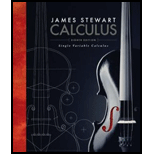
Single Variable Calculus
8th Edition
ISBN: 9781305266636
Author: James Stewart
Publisher: Cengage Learning
expand_more
expand_more
format_list_bulleted
Concept explainers
Textbook Question
Chapter 9.2, Problem 5E
Match the
5. y′ = x + y – 1
- I
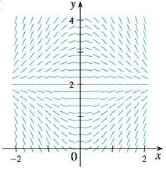
- II
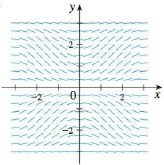
- III
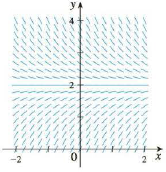
- IV
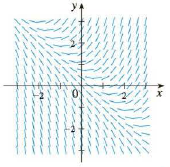
Expert Solution & Answer
Want to see the full answer?
Check out a sample textbook solution
Students have asked these similar questions
Question 1. (10 points)
A researcher is studying tumours in mice. The growth rate for the volume of the tumour V(t) in cm³ is given by
dV
=
1.45V(2 In(V+1)).
dt
(a) (4 pts) Find all the equilibria and determine their stability using the stability condition.
(b) (2 pts) Draw the phase plot f(V) versus V where f(V) = V'. You may find it helpful to use Desmos or Wolfram Alpha to plot the graph of
f(V) versus V (both are free to use online), or you can plot it by hand if you like. On the plot identify each equilibrium as stable or unstable.
(c) (4 pts) Draw direction arrows for the case where the tumour starts at size 3cm³ and for the case where the tumour starts at size 9cm³. Explain
in biological terms what happens to the size of each of these tumours at time progresses.
For the system consisting of the two planes:plane 1: -x + y + z = 0plane 2: 3x + y + 3z = 0a) Are the planes parallel and/or coincident? Justify your answer. What does this tell you about the solution to the system?b) Solve the system (if possible). Show a complete solution. If there is a line of intersection express it in parametric form.
Question 2: (10 points) Evaluate the definite integral.
Use the following form of the definition of the integral to evaluate the integral:
Theorem: Iff is integrable on [a, b], then
where Ax = (ba)/n and x₂ = a + i^x.
You might need the following formulas.
IM³
L² (3x²
(3x²+2x-
2x - 1)dx.
n
[f(z)dz lim f(x)Az
a
n→∞
i=1
n(n + 1)
2
n
i=1
n(n+1)(2n+1)
6
Chapter 9 Solutions
Single Variable Calculus
Ch. 9.1 - Show that y=23ex+e2x is a solution of the...Ch. 9.1 - Verify that y = t cos t t is a solution of the...Ch. 9.1 - (a) For what values of r does the function y = erx...Ch. 9.1 - (a) For what values of k does the function y = cos...Ch. 9.1 - Which of the following functions are solutions of...Ch. 9.1 - Prob. 6ECh. 9.1 - (a) What can you say about a solution of the...Ch. 9.1 - (a) What can you say about the graph of a solution...Ch. 9.1 - A population is modeled by the differential...Ch. 9.1 - The Fitzhugh-Nagumo model for the electrical...
Ch. 9.1 - Prob. 11ECh. 9.1 - Prob. 12ECh. 9.1 - Prob. 13ECh. 9.1 - Suppose you have just poured a cup of freshly...Ch. 9.1 - Psychologists interested in learning theory study...Ch. 9.1 - Von Bertalanffys equation states that the rate of...Ch. 9.1 - Prob. 17ECh. 9.2 - A direction field for the differential equation y...Ch. 9.2 - A direction field for the differential equation...Ch. 9.2 - Match the differential equation with its direction...Ch. 9.2 - Match the differential equation with its direction...Ch. 9.2 - Match the differential equation with its direction...Ch. 9.2 - Prob. 6ECh. 9.2 - Prob. 7ECh. 9.2 - Prob. 8ECh. 9.2 - Prob. 9ECh. 9.2 - Sketch a direction field for the differential...Ch. 9.2 - Prob. 11ECh. 9.2 - Prob. 12ECh. 9.2 - Prob. 13ECh. 9.2 - Prob. 14ECh. 9.2 - Prob. 19ECh. 9.2 - Prob. 20ECh. 9.2 - Prob. 21ECh. 9.2 - Use Eulers method with step size 0.2 to estimate...Ch. 9.2 - Prob. 23ECh. 9.2 - (a) Use Eulers method with step size 0.2 to...Ch. 9.2 - The figure shows a circuit containing an...Ch. 9.3 - Solve the differential equation. 1. dydx=3x2y2Ch. 9.3 - Solve the differential equation. 2. dydx=xyCh. 9.3 - Prob. 3ECh. 9.3 - Solve the differential equation. 4. y + xey = 0Ch. 9.3 - Prob. 5ECh. 9.3 - Solve the differential equation. 6....Ch. 9.3 - Prob. 7ECh. 9.3 - Solve the differential equation. 8....Ch. 9.3 - Prob. 9ECh. 9.3 - Solve the differential equation. 10. dzdt+et+z=0Ch. 9.3 - Find the solution of the differential equation...Ch. 9.3 - Find the solution of the differential equation...Ch. 9.3 - Find the solution of the differential equation...Ch. 9.3 - Find the solution of the differential equation...Ch. 9.3 - Prob. 15ECh. 9.3 - Find the solution of the differential equation...Ch. 9.3 - Find the solution of the differential equation...Ch. 9.3 - Prob. 18ECh. 9.3 - Prob. 19ECh. 9.3 - Find the function f such that f(x) = xf(x) x and...Ch. 9.3 - Solve the differential equation y = x + y by...Ch. 9.3 - Solve the differential equation xy = y + xey/x by...Ch. 9.3 - (a) Solve the differential equationy=2x1y2. (b)...Ch. 9.3 - Solve the equation ey y + cos x = 0 and graph...Ch. 9.3 - Find the orthogonal trajectories of the family of...Ch. 9.3 - Find the orthogonal trajectories of the family of...Ch. 9.3 - Prob. 31ECh. 9.3 - Prob. 32ECh. 9.3 - Prob. 33ECh. 9.3 - Prob. 34ECh. 9.3 - An integral equation is an equation that contains...Ch. 9.3 - Prob. 36ECh. 9.3 - Prob. 37ECh. 9.3 - Prob. 38ECh. 9.3 - Prob. 39ECh. 9.3 - Prob. 40ECh. 9.3 - Prob. 41ECh. 9.3 - Prob. 42ECh. 9.3 - Prob. 43ECh. 9.3 - A certain small country has 10 billion in paper...Ch. 9.3 - A tank contains 1000 L of brine with 15 kg of...Ch. 9.3 - The air in a room with volume 180 m3 contains...Ch. 9.3 - A vat with 500 gallons of beer contains 4% alcohol...Ch. 9.3 - A tank contains 1000 L of pure water. Brine that...Ch. 9.3 - When a raindrop falls, it increases in size and so...Ch. 9.3 - Prob. 50ECh. 9.3 - Prob. 51ECh. 9.3 - A model for tumor growth is given by the Gompertz...Ch. 9.3 - Prob. 54ECh. 9.4 - A population grows according to the given logistic...Ch. 9.4 - A population grows according to the given logistic...Ch. 9.4 - The Pacific halibut fishery has been modeled by...Ch. 9.4 - Suppose a population P(t) satisfies...Ch. 9.4 - Prob. 7ECh. 9.4 - The table gives the number of yeast cells in a new...Ch. 9.4 - Prob. 9ECh. 9.4 - (a) Assume that the carrying capacity for the US...Ch. 9.4 - One model for the spread of a rumor is that the...Ch. 9.4 - Biologists stocked a lake with 400 fish and...Ch. 9.4 - Prob. 13ECh. 9.4 - Prob. 14ECh. 9.4 - Prob. 16ECh. 9.4 - Consider a population P = P(t) with constant...Ch. 9.4 - Let c be a positive number. A differential...Ch. 9.4 - Prob. 21ECh. 9.4 - Prob. 22ECh. 9.4 - Prob. 23ECh. 9.4 - Prob. 24ECh. 9.4 - Prob. 25ECh. 9.5 - Prob. 1ECh. 9.5 - Prob. 2ECh. 9.5 - Prob. 3ECh. 9.5 - Prob. 4ECh. 9.5 - Prob. 5ECh. 9.5 - Prob. 6ECh. 9.5 - Prob. 7ECh. 9.5 - Solve the differential equation. 8. 4x3y + x4y =...Ch. 9.5 - Prob. 9ECh. 9.5 - Prob. 10ECh. 9.5 - Prob. 11ECh. 9.5 - Prob. 12ECh. 9.5 - Prob. 13ECh. 9.5 - Prob. 14ECh. 9.5 - Prob. 15ECh. 9.5 - Prob. 16ECh. 9.5 - Prob. 17ECh. 9.5 - Prob. 18ECh. 9.5 - Prob. 19ECh. 9.5 - Prob. 20ECh. 9.5 - Prob. 21ECh. 9.5 - Prob. 22ECh. 9.5 - Prob. 23ECh. 9.5 - Prob. 24ECh. 9.5 - Prob. 25ECh. 9.5 - Solve the second-order equation xy + 2y = 12x2 by...Ch. 9.5 - Prob. 27ECh. 9.5 - Prob. 28ECh. 9.5 - The figure shows a circuit containing an...Ch. 9.5 - Prob. 30ECh. 9.5 - Prob. 31ECh. 9.5 - Two new workers were hired for an assembly line....Ch. 9.5 - Prob. 33ECh. 9.5 - Prob. 34ECh. 9.5 - Prob. 35ECh. 9.5 - Prob. 36ECh. 9.5 - Prob. 37ECh. 9.5 - To account for seasonal variation in the logistic...Ch. 9.6 - Prob. 1ECh. 9.6 - Prob. 2ECh. 9.6 - Prob. 3ECh. 9.6 - Prob. 4ECh. 9.6 - Prob. 5ECh. 9.6 - A phase trajectory is shown for populations of...Ch. 9.6 - Graphs of populations of two species are shown....Ch. 9.6 - Prob. 8ECh. 9.6 - Populations of aphids and ladybugs are modeled by...Ch. 9.6 - In Example 1 we used Lotka-Volterra equations to...Ch. 9 - (a) What is a differential equation? (b) What is...Ch. 9 - Prob. 2RCCCh. 9 - Prob. 3RCCCh. 9 - Prob. 4RCCCh. 9 - Prob. 5RCCCh. 9 - Prob. 6RCCCh. 9 - (a) Write a differential equation that expresses...Ch. 9 - Prob. 8RCCCh. 9 - Prob. 9RCCCh. 9 - Prob. 1RQCh. 9 - Determine whether the statement is true or false....Ch. 9 - Prob. 3RQCh. 9 - Prob. 4RQCh. 9 - Prob. 5RQCh. 9 - Prob. 6RQCh. 9 - Prob. 7RQCh. 9 - Prob. 1RECh. 9 - Prob. 2RECh. 9 - Prob. 3RECh. 9 - Prob. 4RECh. 9 - Prob. 5RECh. 9 - Prob. 6RECh. 9 - Prob. 7RECh. 9 - Prob. 8RECh. 9 - Prob. 9RECh. 9 - Solve the initial-value problem. 10. (1 + cos x)y...Ch. 9 - Prob. 11RECh. 9 - Prob. 12RECh. 9 - Prob. 13RECh. 9 - Find the orthogonal trajectories of the family of...Ch. 9 - Prob. 15RECh. 9 - (a) The population of the world was 6.1 billion in...Ch. 9 - Prob. 17RECh. 9 - Prob. 18RECh. 9 - Prob. 19RECh. 9 - Prob. 20RECh. 9 - Prob. 21RECh. 9 - Prob. 22RECh. 9 - Prob. 23RECh. 9 - Prob. 24RECh. 9 - Prob. 1PCh. 9 - Prob. 2PCh. 9 - Prob. 3PCh. 9 - Prob. 4PCh. 9 - Prob. 5PCh. 9 - A subtangent is a portion of the x-axis that lies...Ch. 9 - Prob. 7PCh. 9 - Prob. 8PCh. 9 - A dog sees a rabbit running in a straight line...Ch. 9 - Prob. 10PCh. 9 - Prob. 11PCh. 9 - Prob. 12PCh. 9 - Prob. 13PCh. 9 - Prob. 14PCh. 9 - Prob. 15P
Knowledge Booster
Learn more about
Need a deep-dive on the concept behind this application? Look no further. Learn more about this topic, calculus and related others by exploring similar questions and additional content below.Similar questions
- For the system consisting of the three planes:plane 1: -4x + 4y - 2z = -8plane 2: 2x + 2y + 4z = 20plane 3: -2x - 3y + z = -1a) Are any of the planes parallel and/or coincident? Justify your answer.b) Determine if the normals are coplanar. What does this tell you about the system?c) Solve the system if possible. Show a complete solution (do not use matrix operations). Classify the system using the terms: consistent, inconsistent, dependent and/or independent.arrow_forwardFor the system consisting of the three planes:plane 1: -4x + 4y - 2z = -8plane 2: 2x + 2y + 4z = 20plane 3: -2x - 3y + z = -1a) Are any of the planes parallel and/or coincident? Justify your answer.b) Determine if the normals are coplanar. What does this tell you about the system?c) Solve the system if possible. Show a complete solution (do not use matrix operations). Classify the system using the terms: consistent, inconsistent, dependent and/or independent.arrow_forwardOpen your tool box and find geometric methods, symmetries of even and odd functions and the evaluation theorem. Use these to calculate the following definite integrals. Note that you should not use Riemann sums for this problem. (a) (4 pts) (b) (2 pts) 3 S³ 0 3-x+9-dz x3 + sin(x) x4 + cos(x) dx (c) (4 pts) L 1-|x|dxarrow_forward
- An engineer is designing a pipeline which is supposed to connect two points P and S. The engineer decides to do it in three sections. The first section runs from point P to point Q, and costs $48 per mile to lay, the second section runs from point Q to point R and costs $54 per mile, the third runs from point R to point S and costs $44 per mile. Looking at the diagram below, you see that if you know the lengths marked x and y, then you know the positions of Q and R. Find the values of x and y which minimize the cost of the pipeline. Please show your answers to 4 decimal places. 2 Miles x = 1 Mile R 10 miles miles y = milesarrow_forwardAn open-top rectangular box is being constructed to hold a volume of 150 in³. The base of the box is made from a material costing 7 cents/in². The front of the box must be decorated, and will cost 11 cents/in². The remainder of the sides will cost 3 cents/in². Find the dimensions that will minimize the cost of constructing this box. Please show your answers to at least 4 decimal places. Front width: Depth: in. in. Height: in.arrow_forwardFind and classify the critical points of z = (x² – 8x) (y² – 6y). Local maximums: Local minimums: Saddle points: - For each classification, enter a list of ordered pairs (x, y) where the max/min/saddle occurs. Enter DNE if there are no points for a classification.arrow_forward
- Suppose that f(x, y, z) = (x − 2)² + (y – 2)² + (z − 2)² with 0 < x, y, z and x+y+z≤ 10. 1. The critical point of f(x, y, z) is at (a, b, c). Then a = b = C = 2. Absolute minimum of f(x, y, z) is and the absolute maximum isarrow_forwardThe spread of an infectious disease is often modeled using the following autonomous differential equation: dI - - BI(N − I) − MI, dt where I is the number of infected people, N is the total size of the population being modeled, ẞ is a constant determining the rate of transmission, and μ is the rate at which people recover from infection. Close a) (5 points) Suppose ẞ = 0.01, N = 1000, and µ = 2. Find all equilibria. b) (5 points) For the equilbria in part a), determine whether each is stable or unstable. c) (3 points) Suppose ƒ(I) = d. Draw a phase plot of f against I. (You can use Wolfram Alpha or Desmos to plot the function, or draw the dt function by hand.) Identify the equilibria as stable or unstable in the graph. d) (2 points) Explain the biological meaning of these equilibria being stable or unstable.arrow_forwardFind the indefinite integral. Check Answer: 7x 4 + 1x dxarrow_forward
arrow_back_ios
SEE MORE QUESTIONS
arrow_forward_ios
Recommended textbooks for you
 Calculus: Early TranscendentalsCalculusISBN:9781285741550Author:James StewartPublisher:Cengage Learning
Calculus: Early TranscendentalsCalculusISBN:9781285741550Author:James StewartPublisher:Cengage Learning Thomas' Calculus (14th Edition)CalculusISBN:9780134438986Author:Joel R. Hass, Christopher E. Heil, Maurice D. WeirPublisher:PEARSON
Thomas' Calculus (14th Edition)CalculusISBN:9780134438986Author:Joel R. Hass, Christopher E. Heil, Maurice D. WeirPublisher:PEARSON Calculus: Early Transcendentals (3rd Edition)CalculusISBN:9780134763644Author:William L. Briggs, Lyle Cochran, Bernard Gillett, Eric SchulzPublisher:PEARSON
Calculus: Early Transcendentals (3rd Edition)CalculusISBN:9780134763644Author:William L. Briggs, Lyle Cochran, Bernard Gillett, Eric SchulzPublisher:PEARSON Calculus: Early TranscendentalsCalculusISBN:9781319050740Author:Jon Rogawski, Colin Adams, Robert FranzosaPublisher:W. H. Freeman
Calculus: Early TranscendentalsCalculusISBN:9781319050740Author:Jon Rogawski, Colin Adams, Robert FranzosaPublisher:W. H. Freeman
 Calculus: Early Transcendental FunctionsCalculusISBN:9781337552516Author:Ron Larson, Bruce H. EdwardsPublisher:Cengage Learning
Calculus: Early Transcendental FunctionsCalculusISBN:9781337552516Author:Ron Larson, Bruce H. EdwardsPublisher:Cengage Learning

Calculus: Early Transcendentals
Calculus
ISBN:9781285741550
Author:James Stewart
Publisher:Cengage Learning

Thomas' Calculus (14th Edition)
Calculus
ISBN:9780134438986
Author:Joel R. Hass, Christopher E. Heil, Maurice D. Weir
Publisher:PEARSON

Calculus: Early Transcendentals (3rd Edition)
Calculus
ISBN:9780134763644
Author:William L. Briggs, Lyle Cochran, Bernard Gillett, Eric Schulz
Publisher:PEARSON

Calculus: Early Transcendentals
Calculus
ISBN:9781319050740
Author:Jon Rogawski, Colin Adams, Robert Franzosa
Publisher:W. H. Freeman


Calculus: Early Transcendental Functions
Calculus
ISBN:9781337552516
Author:Ron Larson, Bruce H. Edwards
Publisher:Cengage Learning
01 - What Is A Differential Equation in Calculus? Learn to Solve Ordinary Differential Equations.; Author: Math and Science;https://www.youtube.com/watch?v=K80YEHQpx9g;License: Standard YouTube License, CC-BY
Higher Order Differential Equation with constant coefficient (GATE) (Part 1) l GATE 2018; Author: GATE Lectures by Dishank;https://www.youtube.com/watch?v=ODxP7BbqAjA;License: Standard YouTube License, CC-BY
Solution of Differential Equations and Initial Value Problems; Author: Jefril Amboy;https://www.youtube.com/watch?v=Q68sk7XS-dc;License: Standard YouTube License, CC-BY